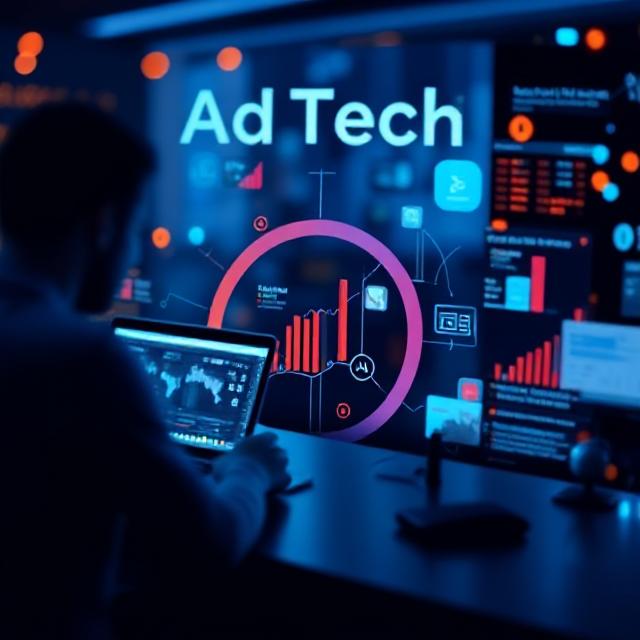There is a huge change happening in the advertising technology (AdTech) business. The global AdTech business is expected to grow at a constant rate of 13.42% per year, reaching $ 578.87 billion by 2025. It was worth more than $ 510.37 billion in 2024. It’s not just about higher budgets that are driving this tremendous rise; it’s also about better, more targeted and privacy-conscious advertising approaches. As we go into a new era shaped by AI, automation and rules, it’s no longer optional to know what’s going on in AdTech it’s necessary.
Getting to Know the Modern AdTech Ecosystem
AdTech is all about the software and technologies that run, manage and improve digital advertising campaigns. The ecosystem is complex yet it is becoming increasingly automated. It includes demand-side platforms (DSPs), supply-side platforms (SSPs), ad exchanges, data management platforms (DMPs) and creative optimisation engines.
In particular, programmatic advertising is still the most popular. With real-time bidding (RTB), advertisers may buy ad space in milliseconds, making sure that each impression goes to the correct user at the right time. New channels like connected TV (CTV), native advertising and shoppable video commercials are becoming more popular especially in places like APAC and North America where digital penetration is highest.
Key Factors Driving Growth in the AdTech Market
There are several things that are driving the AdTech revolution:
1) Artificial intelligence (AI) and Machine learning (ML): AI algorithms are increasingly important for anticipating user behaviour, customising information and improving bidding techniques in real time.
2) Move to First-Party Data: Advertisers are switching to first-party and contextual data for compliant, accurate targeting as third-party cookies become less common.
3) CTV and Mobile Boom: Advertisers are rushing to this channel with a strong retention rate since CTV ad revenue is estimated to reach more than $30 billion by 2025. In contrast, mobile advertising continues to hold the largest share of the market.
4) Retail Media Networks: Amazon, Walmart and Instacart are changing the way people think about advertising by making closed-loop retail media ecosystems.
Problems the Industry Is Facing
Despite the growth of the AdTech market, it continues to face significant challenges. Laws like the EU’s Digital Services Act and California’s CCPA are making it harder to gather and exploit consumer data. Meanwhile, the sector has been shaken by Google’s 2025 antitrust action, and a potential reorganisation is imminent.
Additionally, advertisers and publishers continue to face issues such as ad fraud, a lack of transparency and unclear measurement standards.
Who’s in Charge?
There are only a few big companies that control the global AdTech business. Google, Meta, Amazon, ByteDance and Alibaba together make up more than half of the world’s digital ad income. But independent platforms like Equativ, TripleLift and The Trade Desk are finding their niches by focusing on privacy-first solutions, innovation and openness.
Investors are also changing the game by pushing for consolidation and better ways to make money. As a result, there are more leadership changes and mergers and acquisitions than ever before. This means that the market is becoming more mature and competitive.
What comes next? The Future of AdTech
Several important developments will impact the AdTech sector in the future:
1) The return of contextual advertising: As privacy concerns grow targeting based on context is making a strong comeback.
2) Blockchain for Ad Transparency: The use of blockchain in advertising is still in its early stages, but it is expected to help with problems like ad fraud and lack of visibility in the supply chain.
3) Outcome-Based Advertising: Brands are moving away from impressions and toward real results, like sales, sign-ups and return on investment (ROI).
4) AI-Powered Personalisation: Real-time creative optimisation and hypertargeting will become more accurate while respecting people’s privacy.
The AdTech market in 2025 is a fast-changing, dynamic ecosystem. It isn’t only about being innovative; it’s also about finding the right balance between privacy and precise targeting. Businesses need to quickly change to keep up with the advent of AI, CTV and first-party data initiatives.
The message is obvious for brands, agencies and publishers: those who accept the new rules, technologies and ways of thinking will be the ones who lead the digital advertising revolution.
About the Author
Khubi Agarwal is a passionate Content writer and a certified Digital Marketer with a strong focus on content writing, copywriting and social media marketing. Currently pursuing B.Com (Hons), she is a certified Digital Marketing graduate and gained hands-on experience working on various projects involving SEO, content strategy and social media campaigns. As a content writing intern at Market Research Future (MRFR), Khubi combines creativity with strategy to produce engaging content. With a keen interest in staying ahead of digital trends, she loves crafting compelling stories that connect with audiences and drive results.
Subscribe to Updates
Get the latest creative news from FooBar about art, design and business.



